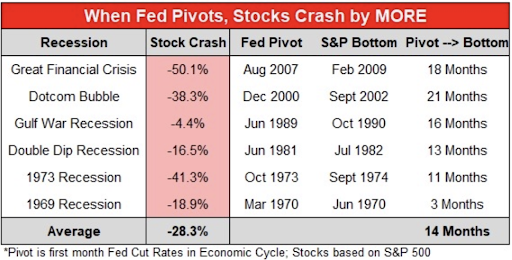Learning how to identify breakout stocks is both an art and a science.
Most traders rely on visual analysis and technical indicators to help them find high-probability setups that produce less false breakout signals.
Today, I want to show you how to identify breakout stocks so you can see the right type of setups and patterns to look for.
But for a little disclaimer, these are not trade recommendations. They’re analyses of setups so you can see how I visually analyze stocks.
How to Identify Breakout Stocks: The Inside Day Pattern
The first pattern is a bullish inside day pattern. This is a simple, short-term pattern that looks for stocks trading inside of each previous day for three days in a row.
The pattern looks like a mini triangle, often occurring after a strong trend comes to a temporary pause for a few days.
What I like most about this pattern is it provides low-risk entry opportunities. That’s because volatility and the length of the candlesticks (or trading bars) are greatly reduced from the normal day-to-day volatility of the stock.
This provides a good, low-risk entry area without having to expose ourselves to excessive risk due to extended volatility, which causes extended trading range and more risk.
You can see in the example below how Medicines Co. (Nasdaq: MDCO) is still in a strong uptrend and consolidating temporarily.
The stock looks like it will continue moving to the upside in the near future.
The Tail Gap Down Pattern
Traders who follow my tutorials know that one of my favorite stock patterns is the Tail Gap Strategy.
I recently posted a tutorial on the Tail Gap Strategy. If you missed it, you can check it out here!
The strategy consists of a pullback away from the main trend that’s accompanied by a gap.
If you look at the chart below, you’ll see several Tail Gap pattern setups in this example of Las Vegas Sands Corp. (NYSE: LVS).
Notice that I’m only taking long tail gap trades because the long-term trend is clearly up.
The tail gap setup usually only lasts a few days because I want to see the stock go back quickly in line with the trend.
A reduction in volatility and trading range is not what I want to see after the setup is triggered. I like to see the stock get back in line with the trend within a few days of triggering.
The chart above is an example of how LVS fell quickly back in line with the trend after trading higher after the set up was triggered.
52-Week High and Ascending Triangle Pattern
Some of the best setups are combination patterns, meaning two patterns occur at the same time.
This increases the probability of trades working out even further, especially if both patterns have no conflicts between them. In this particular case, we have a one-year high breakout coupled with an ascending triangle pattern.
Notice in the chart above how Tesoro Logistics LP (NYSE: TLLP) tried to break above the resistance area several times before.
The trend is strong and everything technically points to an increase in price for this stock. When multiple trades and setups line up with each other, it creates the best type of environment for short-term trading.
Other Ways To Increase Your Probabilities and Identify Breakout Stocks
When analyzing stocks for high-probability entry setups, make sure to study the underlying sector. Also make sure the majority of stocks in that sector are pointing in the same direction as your setup pick.
Moreover, make sure the stock market is pointing in the same direction as your picks because, as you know, there’s a strong correlation between the stock market and individual stocks.
Many failed trades could be avoided by following these two basic principles and using solid trading setups as well.
For more articles on similar topics please go to: The Best Pullback Strategy for Beginner Traders: The 4×4 Strategy and 1 Simple Pullback Strategy That Actually Works: The Tail Gap Strategy.
All the best,
Roger Scott
Senior Strategist, WealthPress




